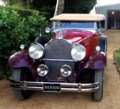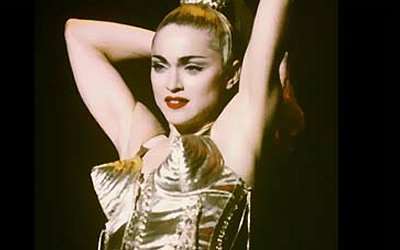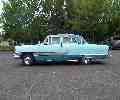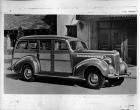|
Re: We haven't had a good "What If?" for a while, so.....
|
||||
|---|---|---|---|---|
|
Home away from home
|
Quote:
Photo Source: Wikimedia Commons "Well... Thank you!"
Posted on: 2012/3/25 8:52
|
|||
|
||||
|
Re: We haven't had a good "What If?" for a while, so.....
|
||||
|---|---|---|---|---|
|
Home away from home

|
Quote:
Attach file:  (9.83 KB) (9.83 KB)
Posted on: 2012/4/2 6:06
|
|||
|
1930 Deluxe 8 745 Dual Cowl Sport Phaeton
See me in the Registry |
||||
|
||||
|
Re: We haven't had a good "What If?" for a while, so.....
|
||||
|---|---|---|---|---|
|
Home away from home

|
Hi
Always enjoy a thought-provoking What If! So many good points made so far, but I'll have take up the original question first. Earl would have viewed a stint at Packard as a stepping stone to the premiere position in the field as leader of GM's Art and Color, anything less would have been intolerable. His talent and design sense was mated to an immense ego, one that could never be happy affecting the design direction of a relatively small, independent carmaker. Earl knew mass production was where he could have the greatest affect, as market saturation had a way of creating taste for his design idiom. He learned quickly with his '27 LaSalle that high style could influence the whole industry to copy his direction. ".......HH56 makes a sobering argument about the critical role of mgmt. Over at GM it really wasn't Earl by himself, it was him and Sloan and others acting in concert." Where Earl and the Packard management would have quickly run afoul was Earl's willingness to try bold new styling that owed nothing to the current idiom, as exampled by the '34 LaSalle. Cutting his design teeth in California, he understood a percentage of the upscale tastemakers would embrace progressive styling as an indication of their social outlook. His success in the pre-GM period was presenting styling counter to the prevailing staid, conservative norm. More importantly, Earl understood the major role styling would come to play in influencing buying decisions as the mechanical aspects became more robust and dependable for all price segments. The other adherent of this outlook was Alfred Sloan, who supported Earl's judgment, abetted his drive to develop GM Art & Color into the styling juggernaut it became. Sloan also had the final say when engineering might bridle at some design or feature deemed too costly to produce. His trust in and support for Earl's judgment was without question and absolutely indispensable . By contrast, Macauley and board were pleased enough to allow son Ed and his small group to develop evolutionary designs, always with the final approval by the engineering department. This approach left Packard woefully ill-equipped to respond as GM drove customer preference by sheer saturation. It also put them in a more vulnerable position once they entered volume competition with GM through the Junior series. Had they taken note of Chrysler and the other independent carmakers and their design department developments, they might have realized how far behind they were falling. Packard's evolutionary approach was fine for the luxury car segment in the 1920's on into the mid-1930's, until the introduction of three seminal cars which appeared on the heels of the '34 LaSalle. One was the '36 Cadillac 60 which began the democratization of the luxury car in earnest below the $2,000 segment. Less a matter of style, it proved the acceptance of a smaller, owner-driven, high-performance luxury sedan, the "pocket luxury car" if you will. The cultural outlook was changing to a more egalitarian one that prized less the display of wealth through the grandiose luxury cars offered up to that time. Concurrently, the Cord 810 demonstrated how lowered, avant-garde design could grasp the attention of upscale customers out of proportion to actual sales numbers. To bring about the third influential car, fortuitously Earl had hired 25 year old Bill Mitchell to head Cadillac styling in late 1935. His first assignment was to design a youthful new LaSalle sport sedan. Also fortuitously, management decided to build it as a Cadillac, realizing the role of styling leader should be held by their flagship, not by it's companion marque. The stage was now set. "......based on the hard historical fact that the 60 Special changed the industry fundamentally, particularly the luxury car segment. In one sweep of Bill Mitchell's brush the traditional touring sedan was done. " Key to the success of the 60 Special was it's breakthrough presentation of the 3-box sedan configuration, instantly rendering the touring sedan as old-fashioned. While the latter still had market life left in the lower priced segments, upper medium and luxury customers enthusiastically embraced this exciting new sedan architecture. Heretofore, the 3-box sedan had been seen on occasional custom bodies as an extension of the club sedan. Suddenly, the '38 60 Special made available to tastemakers the ideal combination of capable chassis, owner-driven size, lowered 3-box configuration in a production sedan of moderate luxury car price. Bingo! Earl and Sloan realized instantly they had a winner when it quickly accounted for 40% of Cadillac sales. Never one to let a success go unexploited, Earl set Art & Color upon the task of creating sportier mass-market 3-box sedan concepts. The introduction was reserved for the upper series models of each make, Pontiac through Cadillac; whereupon the C-body torpedo sedans and coupes took the 1940 market by storm. To understand the long-term major sea change taking place initiated by this new configuration, touring sedans dominated in 1938; by 1949, the 3-box sedan supremacy was complete. This is the point were Packard was running scared to death of GM, realizing it's volume 110 and 120, so central to profitability, were going head to head against these popular new styles while still fielding reworked '38 model touring sedan bodies. The panicked initiation of the Clipper project began at this point. Indicative of the complacent attitude settling over East Grand mahogany row is the very fact they had failed to act on this important design trend a year or two prior or better yet, initiate it. While it's true Packard's market thrust had turned largely to the medium-priced segment where the touring sedan still held sway, their own 'pocket luxury' '39 Super Eight offered nothing to attract the important tastemaker market. It was the "lugs loosening badly and wheels wobbling" for Packard's market position. The Clipper arrived almost in the nick of time, at least it kept them in the game for a while. Frightening to consider if it hadn't and they had to enter the postwar market dependent upon another rework of the '38 bodies....gulp! Shades of Hudson's modus operandi (they reworked their bodies from 1936 through 1947). Now, as to what designers and approach could have prevented this slide. Their first opportunity came early in the Depression when Ray Dietrich was cut adrift from the eponymous Murray body division. His talents were picked up by Chrysler, only to be frustrated and wasted by a domineering engineering department. Although Dietrich was friends with Walter P. Chrysler, who actually hired him, WPC didn't backstop Dietrich as Sloan did for Earl. For Packard, which had benefited so greatly from Dietrich's talents, it was an oversight of tragic proportions to fail to hire him in 1932. Dietrich had, at times, contributed custom styles that may have rankled engineering but were championed by the Macauley and proved to be of considerable market merit. The artist and patron relationship was in place, needed only to be brought to bear on production designs. Attributed to Dietrich are concepts for the 120 which were very much nascent 3-box body architecture, were bypassed in favor of the safe route of the touring sedan. Less a problematic decision in '35, shortly it would become one with the '38 "shot-across-the-bow" 60 Special, to a full-fledged market crisis with the '40 GM Torpedo C-body. Another missed opportunity was failing to engage Dutch Darrin as design consultant when his '38 Eight-based customs came to grab public attention piloted by Hollywood glitterati. Macauley and company may have been worried about offending staid, conservative customers. As long as they offered a few such long-wheelbase sedans/limousine, that market was still their oyster. After all, Cadillac built the 75 for those who would consider nothing other than an over-cabbed touring sedan. Surprisingly, those conservative customers were changing their outlook to encompass more stylish progressive designs as well. One additional young designer that came to Packard's attention during the Darrin episode was Art Fitzpatrick who was responsible for the '40 Darrin Sport Sedan design. He had the potential to do for Packard what Bill Mitchell did for Cadillac. Others such as Bob Bourke, Gordon Buehrig could have been enticed to join Packard design had management resolved to make it's styling department as capable as those of it's competitors. Within, Howard Yeager and John Reinhart should have been given the freedom to design without engineering interference. The central point is that with a full-developed styling department staffed by highly-talented designers supported with the patronage of upper management rather than dominated by engineering could have made all the difference. Your thoughts sought. Pose a simple "What If", get a dissertation! Steve
Posted on: 2012/4/8 10:58
|
|||
|
||||
|
Re: We haven't had a good "What If?" for a while, so.....
|
||||
|---|---|---|---|---|
|
Home away from home

|
WOW!
Three box design?
Posted on: 2012/4/8 15:19
|
|||
|
When two men ride the same horse, one has to be in the back...
|
||||
|
||||
|
Re: We haven't had a good "What If?" for a while, so.....
|
||||
|---|---|---|---|---|
|
Home away from home
|
That was excellent, Steve. Thanks.
A few years ago at Warren they had the big '37 exposition and I was stunned by number of different models and bodies available. Even forgetting the custom stuff the tooling expense had to have been phenomenal. Just a few years later Packard and others could scarcely tool a full lineup--for example no Clipper convertibles and just a 2 and 4 door sedan. A little later yet and Packard spent a huge sum of money just to rebody the clipper into the 22nd series. 11 million was it? And that with enough carryover parts that the slogan should have been "First by far with a prewar car". I have not been able to reckon how such a drastic change in tooling and production capability happened in the space of ten years. Would love to hear some insider comments.
Posted on: 2012/4/8 20:10
|
|||
|
||||
|
Re: We haven't had a good "What If?" for a while, so.....
|
||||
|---|---|---|---|---|
|
Home away from home

|
Whenever I think of Harley Earl I think of the 1958 Buick Limited (with more chrome surface than paint) and of course the 1959 Cadillac - any version. (shudder)
Posted on: 2012/4/9 0:34
|
|||
|
1951 200 Deluxe Touring Sedan
1951 200 Deluxe Touring Sedan (parts ?) 1951 Patrician Touring Sedan 1955 Patrician Touring Sedan |
||||
|
||||
|
Re: We haven't had a good "What If?" for a while, so.....
|
||||
|---|---|---|---|---|
|
Home away from home

|
Hi
Thanks gentlemen, hope this was thought-provoking, generated consideration of how events might have turned out differently. Patgreen: The following is the definition of 3-box styling from the Glossary of A Century of Automotive Style: 100 Years of American Car Design by Michael Lamm and Dave Holls, page 298: "Box, one-, two-, three-: Body morphology is often described in terms of one-box, two-box and three-box. A one-box body usually refers to a van, whose body looks like one big box. A station wagon or something like the VW Rabbit qualities as a two-box body, the hood being one box and the cabin the second. And a three-box body is usually a conventional sedan or coupe: hood, cabin, trunk. Also called "one-, two-, and three shape."" Personally, I think of the three boxes defined by box one as everything ahead of the windshield, box two as everything behind the windshield and below the window beltline including the integrated trunk, and box three as everything behind the windshield and above the window beltline. The accepted definition probably works just as well for most. In the case of the touring sedan, with an appended trunk, it could be considered a three box by the accepted definition, though strikes me more as a two and a half box design. The 60 Special's integrated trunk with the passenger cabin body mass seems more the second box, crowned by a separate three box. Choose whichever definition that works for you. The five passenger victoria or club coupe is a three box configuration. Bill Mitchell's genius was lengthening the passenger compartment of a club coupe, adding two more doors but keeping the roof 'box' separate. Or maybe it was taking the close-coupled club sedan and integrating a coupe trunk.....either way, he jelled the sedan body configuration we still have today. Pretty smart for a 25 year old guy! Small wonder he became Harley Earl's successor and gave us some marvelous styled '60's cars such as the '63 Corvette Sting Ray, '63 Buick Riviera, '66 Oldsmobile Toronado and '67 Cadillac Eldorado. The entire 1965 GM line-up is the first model year he had completely overseen restyling every car line, very nice job by my estimation. Ross: Packard buried themselves in tooling cost for years, frequently for minimal volume. With regard to 1937, the Senior models were still composite body construction, wood frame, metal panels. Variety was less costly in terms of large, expensive dies. For 1938, the new all-steel Junior bodies, shortly to be shared with Seniors, included stamped, one-piece roof shells which were considerably more costly to tool. The all-steel 'turret' top was the industry norm, a feature they couldn't fail to offer. Main of the reason for the Clipper's limited body style selection had to do with the panicked nature of it's development and late introduction. Time was too scant for them to develop and tool the their usual wide selection of bodies. The Clipper roof shell stamping, the largest in the industry at the time, was one of the motivations for them to turn their body construction work over to Briggs. Briggs perhaps gave them a unit price less than they could so in-house but it set up a precarious situation being dependent upon just one source for a major component. By 1941, there were also the demands of war materiel production which was tying up die-shop resources throughout the industry. There was also something of a voluntary curtailing of civilian work in preference to war material needs even before Pearl Harbor. After the war, with every carmaker scrambling to get die work done for their newly restyled postwar, Briggs really had Packard over a barrel when it came to updating the Clipper for the 22nd Series. Packard had collaborated closely with Brigg's in-house styling department to develop the new styling during the war. To re-equip and tool up for body construction at East Grand was by then prohibitably costly: For them to suddenly seek bids from Murray or Budd would have been going way out on a limb, especially since both were up to their arms in tooling work. In the book mentioned above (recommended reading for a greater understanding of not only Packard but the industry and the era in general), the following section confirms the massive cost, from page 227: "George Christopher was ecstatic, because an all-new body would have been much more expensive. And yet the 1948 Packard, even though it kept all the Clipper's underbody, inner sheet metal, roof and decklid, was anything but a retooling bargain. According to Packard Historian William S. Snyder, who researched company record, Packard spent nearly twice as much tooling its 1948 models as Hudson did that same year on a truly new body. "Maybe Packard had become too accustomed to government work," said Snyder." Other factors that drove up the cost of everything after the war were the shortages of workers and basic materials, steel was at a premium for years. War materiel production had been done with cost-plus government contracts including wages which were much more by the end of the fighting. No one was going to reset wages to pre-war levels. Consider the escalation of the base price of the basic Chevrolet four door sedan: 1941 at $795, by 1946 at $1,123, by 1948 at $1,371. So, though I don't have specific industry figures to offer, Packard wasn't alone in grappling with increasing tooling and production costs in the postwar period. Jim L. in OR: By the mid-'50's GM's design staff came to perceive that Harley Earl was losing his 'touch' and "groping" for a styling direction for the late '50's. As you note, many of the resulting cars were heavy-handed and less-appealing unless over-decorated is one's taste. Earl was due to retire November 30, 1958 at 65 years old. After thirty years of starting, then developing GM Styling into the major industry force that it became, who could blame the fellow for wearing out. As far as the overwrought styling that characterized that era, Earl himself was the main driver behind that idiom, so maybe it became too much even for him. But Earl had mentored Mitchell, who had already demonstrated his ability for clean, tailored design, into the prefect successor, so his legacy was assured. Mitchell drove that trend toward cleaner styling that came throughout in the '60's. Steve
Posted on: 2012/4/9 11:57
|
|||
|
||||
|
Re: We haven't had a good "What If?" for a while, so.....
|
||||
|---|---|---|---|---|
|
Home away from home

|
What if Packard had seen the light and gone back to the luxury car market, rather than trying to compete in the medium-car market?
What if they'd continued Clipper styling for 1-2 more years and come out with '51 style bodies in '50? What if they'd accelerated development of the V-8?
Posted on: 2012/4/9 12:27
|
|||
|
||||
|
Re: We haven't had a good "What If?" for a while, so.....
|
||||
|---|---|---|---|---|
|
Home away from home

|
Harley Earl was not a nice person and neither was Bill Mitchell. Both of them went on firing rampages whenever they felt miffed. In the fifties Earl became a somewhat senile tyrant and impossible.
At Packard there was Werner Gubritz who was universally admired. He was just too professional for the corporate game. Reinhart and Teague were also top notch talent and did a fabulous job given their budgets. I don't know where people get the idea that GM products were universally better looking than Packard. I think most Buicks are ugly and Cadillac evolved into the 1959. The 55-56 Packard Caribbean is still the best looking full sized 50's car in my book. Sure, the Packard radiator is not avant garde and you have to like it to buy it. But gee-whiz the front of the 1938 Cadillac 60-S is horrible. Anybody who thinks that Packard didn't know anything about advanced styling trends should take a look at the 840 Individual Custom Sport Sedan by Dietrich. It's way ahead of the 60-S. Packard management was like all management. They concerned themselves most with eliminating personal threats and advancing personal agendas at the expense of the corporation. So they squandered people like Dietrich. The Cadillacs have weathered time better than Packards. Get behind the wheel of the 60 Special and it is a wonderful car save for the droning of that long stroke V-8. I'm sure though that in 1941 a new Packard was head and shoulders better to drive than the Cadillac. Packard didn't have a lot of money and I have always felt their only hope was merger. But not with Studebaker. In the 50's Ford was wasting almost a billion dollars attempting to compete with Buick, Olds, and Pontiac. If they bought out Packard they would have done much better than the Edsel.
Posted on: 2012/4/9 17:44
|
|||
|
||||








